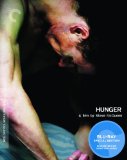| Reviews & Columns |
|
Reviews DVD TV on DVD Blu-ray 4K UHD International DVDs In Theaters Reviews by Studio Video Games Features Collector Series DVDs Easter Egg Database Interviews DVD Talk Radio Feature Articles Columns Anime Talk DVD Savant Horror DVDs The M.O.D. Squad Art House HD Talk Silent DVD
|
DVD Talk Forum |
|
|
| Resources |
|
DVD Price Search Customer Service #'s RCE Info Links |
|
Columns
|
|
|
Hunger
The Criterion Collection // Unrated // February 16, 2010
List Price: $39.95 [Buy now and save at Amazon]
Fair warning: Hunger is a film based on the 1981 hunger strike in Northern Ireland, and this review continually makes reference to the outcome of that well-documented event. Those unfamiliar with Bobby Sands or the hunger strike he led should avoid reading the following review if they wish to avoid having that revealed.
One of the first images glimpsed in Hunger is that of a middle-aged Irish man trudging through a fairly ordinary morning routine. His neatly-folded clothes are waiting for him on the foot of the bed, and after getting dressed, his wife brings him a plate of eggs and pork for breakfast. As he steps foot outside his pleasant suburban home, as he does every morning, Ray Lohan (Stuart Graham) looks back and forth at the houses around him, leans down on the ground, and checks the undercarriage of his sedan for a car bomb. One wouldn't know it to look at him, but Lohan is a guard at Her Majesty's Prison Maze in Dublin during the frenzied peak of the 'Dirty protest'. As crumbs from his toast tumble into the napkin on Lohan's lap, IRA freedom fighters imprisoned in the Maze clatter overturned bowls in protest. As Lohan's wife lovingly pressed and folded his clothing, the prisoners smeared their own excrement on the walls of their cells...molded barriers of maggot-infested, leftover food so they could send basins filled with urine spilling out from under the prison doors. These aren't mindless, feral creatures, but they felt as if they're to be treated like animals, they may as well act the part.
The British government dismissed them as common criminals, refusing to grant these prisoners from the IRA conflict the political status they had once been accorded. Their demands were few -- insisting to wear their own clothes and to have the restrictions with their communication with the world outside lessened, for instance -- but went unacknowledged. During the Dirty protest, their prison cells became uninhabitable...inhuman. Brutal beatings were commonplace. The authorities at times would toy with their demands, seemingly extending an olive branch that they wouldn't have to wear a prison uniform; rather than being able to choose their own clothing, though, they were offered a sweater and slacks...a different uniform, one of British conformity. Identity being the crux of the conflict with Britain in the first place, these proud Irishmen would rather die than be labeled criminals. In 1981, Bobby Sands -- played here by Michael Fassbender -- led a hunger strike that turned the world's eyes to the tumult in Dublin. This is a story of will, pride, and determination. It's also a tale of self-sacrifice and death.
Steve McQueen directs Hunger with such supreme skill and confidence that there's little to suggest that this is his first feature-length film. His short subjects in the years leading up to this had been moving image pieces; he'd never shepherded a cast to any great extent, and yet McQueen coaxes spectacular performances from his actors here. McQueen is disinterested in tethering himself to convention, and that exploration is an integral part of what makes Hunger such an endlessly engaging film. For one, McQueen prefers to let the imagery and performances tell the story. Any other director would've leaned on a title sequence with a montage of newspaper headlines and grainy footage on the telly. We'd likely have have met these men in happier times first. We'd see these soldiers for the IRA in battle. We'd watch them as they're captured. McQueen chooses instead to throw viewers almost immediately inside the walls of the Maze. After the initial contrast between Ray Lohan's morning routine and that of the prisoners he helps to watch over, Hunger's cameras rarely venture outside its confines again. The film is set shortly before Bobby Sands mounted his hunger strike, but to better immerse viewers in this world, McQueen spends much of the first act of the film with
two entirely different prisoners. It's through the two of them that we see what a hellish existence these many men lead, and Hunger's eye is unflinching.
Hunger doesn't revel in its graphic imagery but neither does it turn its head, an approach that comes across as an honest exploration rather than merely gratuitous. Leading up to the final act of the film, there's no shortage of arresting visuals: the subhuman squalor in which these prisoners live, these men with long, stringy hair and unkempt beards being held down and forcefully shorn, proud Irishmen stripped nude and flung through a gauntlet of riot officers, battered all the way by their shields. For the bulk of the film, Hunger unspools with minimal dialogue and no exposition or narration whatsoever. McQueen is able to elegantly establish the film's concepts and conflicts without reams of pages of chatter; there's so much more to learn from what people do...how they react...as opposed what they may say.
The overwhelming majority of Hunger's dialogue is concentrated into a single scene, and though it consists solely of two men speaking to one another in a smoky, underlit room, it's as gripping and unrelentingly intense as any of the more overtly visceral moments before it. This conversation between Sands and Father Moran (Liam Cunningham) defines both the man and the film. The priest argues that Sands is seeking to pen headlines in the ink of his own blood; Sands rebuts with a childhood story about encountering a crippled, dying foal while those around him looked on helplessly. As much time as Hunger had spent aiming its camera at Bobby Sands, it's only here that we truly meet him....along with glimpses of his intelligence and sharp wit, it's here that we come to understand the spirit and determination that drive him. Sands has made up his mind that he's going to lead a hunger strike, and that he's resigning himself to a slow, torturous death -- and at his own hand, no less -- doesn't cause him to waver in the slightest. I was so hopelessly engaged by these two actors' performances that eight or nine minutes passed before I realized that the camera had not budged so much as an inch. This single scene spans some 22 minutes, and for 17 of them, the camera doesn't move and never once cuts away. This massive, immensely powerful stretch of dialogue is all performed in a single take as well. On every conceivable level, it's nothing short of extraordinary, and I'm struggling to think of any other movie in which I'd found myself lost in this sort of
hypnotic thrall for such a length of time.
There is no gradual descent. When next we meet Sands, he's an emaciated shadow of the man we'd come to know. His skeletal frame peppered with open sores, Sands spends his dying days in a sterile hospital room. Plates of food are brought to him day in and day out, but despite the agony he endures, Sands resists that temptation. His bedsheets are spattered with blood from his many lesions, and Sands' skin is so tender that his blanket has to rest on top of a metal frame rather than risk coming in contact with him directly. His toilet is stained with streaks of dark crimson. There are no uplifting monologues. There are no impassioned speeches. We see only a man sacrificing that which he holds most dear -- summoning impossible willpower -- out of a fervent belief that it's the right thing to do. Hunger doesn't allow us to be party to the final words that Sands whispers. This is a man who triumphed in death, his sacrifice bringing the world's attention to Dublin, and yet it's not celebrated in the film by any glorifying montages or soaring strings. Sands' remains are removed with the same clinical detachment as the janitor who sloshes around some cleanser and mops up a hallway drenched with urine.
With cinematographer Sean Bobbitt by his side, McQueen directs with a dazzling visual eye, and the brutality throughout Hunger is nearly matched by its beauty. A snowflake falls on a bloodied knuckle...a janitor in a protective suit pressure blasts a prison cell smeared with human excrement but is briefly entranced by a hypnotic series of concentric circles artfully drawn with that same feces...a fleck of down slowly descends in front of the withered body of a man lay dying. There are also scattered moments of wit and humor that are careful never to intrude on the overall grim tone of the film, such as some of the banter in the conversation between Sands and Father Moran as well as the clever smuggling of messages in the brief,
closely monitored visits the prisoners are allowed.
Without steering this review in too political a direction, it's certainly not difficult to argue that much of the philosophy and troubling imagery of this period piece remain all too relevant today. It's even more easily debated that Hunger isn't close to even-handed with its subjects -- the violence subjected by prison guards far outweighs the single gunshot fired by the IRA in this film -- but this is a movie that is far more fascinated by delving into the scope of one man's sacrifice...what he's doing rather than what he may have done. Bobby Sands believes that he's right, and whether or not the audience shares those sentiments is ultimately inconsequential.
Graphic, uncompromising, and unerringly artful, Hunger is startlingly effective at conveying the agony and suffering of the prisoners housed in H-Block. It makes for an experience that is deliberately excruciating, but that unsettling imagery is the foundation for the physical and emotional connection that ultimately defines the film...the final two acts of a Passion play. Hunger is one of the most unique and endlessly engaging films I've seen in quite a long while, and the heights to which director Steve McQueen may soar from here look to be dizzying indeed. Highly Recommended.
Video
Hunger is a film whose power is largely drawn through its visuals, and its presentation on Blu-ray is nothing short of breathtaking. The levels of detail and clarity are consistently spectacular. The claustrophobia inherent to a movie predominantly set in cramped prison cells and hospital rooms keeps the camera frequently closed in rather tightly, revealing impressively fine textures in skin, clothing, and even paper. Contrast is robust throughout as well, boasting a nearly three-dimensional sense of depth. Hunger's use of color is inspired, generally rendered with warmth outside the walls of the prison but starker and often more desaturated inside, an aesthetic that's shattered only by a nostalgic glow in its final moments. Criterion's presentation is, as expected, flawless. Hunger retains a rich, filmlike texture, showing no signs of being subjected to any heavy-handed digital noise reduction. Its grain structure is tight enough that it never intrudes, for those concerned about those sorts of clean visuals. I was unable to detect any trace of edge enhancement, compression artifacting, or wear whatsoever in the source. This is precisely the sort of perfection I've come to expect from the Criterion Collection.
Hunger's AVC encode spans both layers of this BD-50 disc, and the image has been letterboxed to preserve its original aspect ratio of 2.39:1.
Audio
The 24-bit, six-channel DTS-HD Master Audio soundtrack on this Blu-ray disc is every bit as impressive as well. Ever organic and alive, Hunger's sound design sets out to immerse the viewer in its world, from the reverb of footsteps in the prison halls to the clanging of iron doors to something as understated as tiny crumbs tumbling onto a breakfast napkin. The mix is teeming with subtle splashes of color in the surrounds to flesh out a sense of atmosphere, and I found myself engaged by that as much as I was by its more smoldering intense moments, such as the prisoners violently trashing their dressing rooms and being flung around like ragdolls through a gauntlet of heavily-armored riot officers. The lower frequencies are effective when need be, from the bassy growl of Father Moran's voice to the devastating rumble as Sands nears death. The film's dialogue is rendered with impressive clarity and is balanced perfectly in the mix. Again, I'm left with no complaints or concerns at all; this is a remarkably effective soundtrack that has made its way to Blu-ray flawlessly.
There are no downmixes, alternate soundtracks, or dubs on this Blu-ray disc. English subtitles, captioned for the deaf and hard of hearing, are accessible with a press of a button on the remote.
Extras
The extras on this Blu-ray disc are encoded in high definition, but all except the trailer and the interview with Steve McQueen have been upconverted from lower resolution sources. Hunger also comes packaged with a booklet featuring an essay by film critic Chris Darke.
The Final Word
The ferocity of Hunger's performances fused with Steve McQueen's unflinching direction and the film's unsettling imagery make for a devastatingly powerful experience. This is an artfully crafted and uncompromising story of self-sacrifice, equal parts beautiful, brutal, and philosophical. Emotionally ravaging though Hunger may be -- perhaps too draining for most to be willing to endure it a second time -- this is an extraordinary work of art that demands to be seen. Hunger's presentation on Blu-ray is nearly as exceptional as the film itself, boasting a spectacular high definition presentation and an equally effective master-quality soundtrack. The selection of extras may appear to be lean at first glance but accomplish more in an hour and a half than most Blu-ray discs can in twice that time. Highly Recommended.
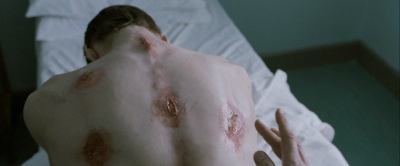 |
| [click on the thumbnail to enlarge] |
The British government dismissed them as common criminals, refusing to grant these prisoners from the IRA conflict the political status they had once been accorded. Their demands were few -- insisting to wear their own clothes and to have the restrictions with their communication with the world outside lessened, for instance -- but went unacknowledged. During the Dirty protest, their prison cells became uninhabitable...inhuman. Brutal beatings were commonplace. The authorities at times would toy with their demands, seemingly extending an olive branch that they wouldn't have to wear a prison uniform; rather than being able to choose their own clothing, though, they were offered a sweater and slacks...a different uniform, one of British conformity. Identity being the crux of the conflict with Britain in the first place, these proud Irishmen would rather die than be labeled criminals. In 1981, Bobby Sands -- played here by Michael Fassbender -- led a hunger strike that turned the world's eyes to the tumult in Dublin. This is a story of will, pride, and determination. It's also a tale of self-sacrifice and death.
Steve McQueen directs Hunger with such supreme skill and confidence that there's little to suggest that this is his first feature-length film. His short subjects in the years leading up to this had been moving image pieces; he'd never shepherded a cast to any great extent, and yet McQueen coaxes spectacular performances from his actors here. McQueen is disinterested in tethering himself to convention, and that exploration is an integral part of what makes Hunger such an endlessly engaging film. For one, McQueen prefers to let the imagery and performances tell the story. Any other director would've leaned on a title sequence with a montage of newspaper headlines and grainy footage on the telly. We'd likely have have met these men in happier times first. We'd see these soldiers for the IRA in battle. We'd watch them as they're captured. McQueen chooses instead to throw viewers almost immediately inside the walls of the Maze. After the initial contrast between Ray Lohan's morning routine and that of the prisoners he helps to watch over, Hunger's cameras rarely venture outside its confines again. The film is set shortly before Bobby Sands mounted his hunger strike, but to better immerse viewers in this world, McQueen spends much of the first act of the film with
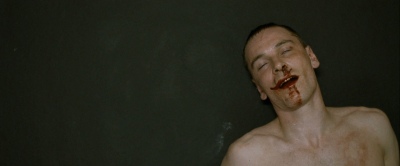 |
| [click on the thumbnail to enlarge] |
Hunger doesn't revel in its graphic imagery but neither does it turn its head, an approach that comes across as an honest exploration rather than merely gratuitous. Leading up to the final act of the film, there's no shortage of arresting visuals: the subhuman squalor in which these prisoners live, these men with long, stringy hair and unkempt beards being held down and forcefully shorn, proud Irishmen stripped nude and flung through a gauntlet of riot officers, battered all the way by their shields. For the bulk of the film, Hunger unspools with minimal dialogue and no exposition or narration whatsoever. McQueen is able to elegantly establish the film's concepts and conflicts without reams of pages of chatter; there's so much more to learn from what people do...how they react...as opposed what they may say.
The overwhelming majority of Hunger's dialogue is concentrated into a single scene, and though it consists solely of two men speaking to one another in a smoky, underlit room, it's as gripping and unrelentingly intense as any of the more overtly visceral moments before it. This conversation between Sands and Father Moran (Liam Cunningham) defines both the man and the film. The priest argues that Sands is seeking to pen headlines in the ink of his own blood; Sands rebuts with a childhood story about encountering a crippled, dying foal while those around him looked on helplessly. As much time as Hunger had spent aiming its camera at Bobby Sands, it's only here that we truly meet him....along with glimpses of his intelligence and sharp wit, it's here that we come to understand the spirit and determination that drive him. Sands has made up his mind that he's going to lead a hunger strike, and that he's resigning himself to a slow, torturous death -- and at his own hand, no less -- doesn't cause him to waver in the slightest. I was so hopelessly engaged by these two actors' performances that eight or nine minutes passed before I realized that the camera had not budged so much as an inch. This single scene spans some 22 minutes, and for 17 of them, the camera doesn't move and never once cuts away. This massive, immensely powerful stretch of dialogue is all performed in a single take as well. On every conceivable level, it's nothing short of extraordinary, and I'm struggling to think of any other movie in which I'd found myself lost in this sort of
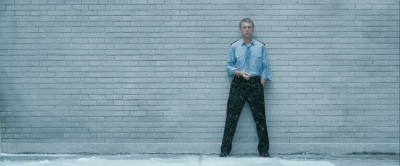 |
| [click on the thumbnail to enlarge] |
There is no gradual descent. When next we meet Sands, he's an emaciated shadow of the man we'd come to know. His skeletal frame peppered with open sores, Sands spends his dying days in a sterile hospital room. Plates of food are brought to him day in and day out, but despite the agony he endures, Sands resists that temptation. His bedsheets are spattered with blood from his many lesions, and Sands' skin is so tender that his blanket has to rest on top of a metal frame rather than risk coming in contact with him directly. His toilet is stained with streaks of dark crimson. There are no uplifting monologues. There are no impassioned speeches. We see only a man sacrificing that which he holds most dear -- summoning impossible willpower -- out of a fervent belief that it's the right thing to do. Hunger doesn't allow us to be party to the final words that Sands whispers. This is a man who triumphed in death, his sacrifice bringing the world's attention to Dublin, and yet it's not celebrated in the film by any glorifying montages or soaring strings. Sands' remains are removed with the same clinical detachment as the janitor who sloshes around some cleanser and mops up a hallway drenched with urine.
With cinematographer Sean Bobbitt by his side, McQueen directs with a dazzling visual eye, and the brutality throughout Hunger is nearly matched by its beauty. A snowflake falls on a bloodied knuckle...a janitor in a protective suit pressure blasts a prison cell smeared with human excrement but is briefly entranced by a hypnotic series of concentric circles artfully drawn with that same feces...a fleck of down slowly descends in front of the withered body of a man lay dying. There are also scattered moments of wit and humor that are careful never to intrude on the overall grim tone of the film, such as some of the banter in the conversation between Sands and Father Moran as well as the clever smuggling of messages in the brief,
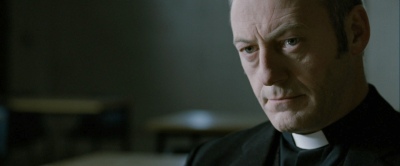 |
| [click on the thumbnail to enlarge] |
Without steering this review in too political a direction, it's certainly not difficult to argue that much of the philosophy and troubling imagery of this period piece remain all too relevant today. It's even more easily debated that Hunger isn't close to even-handed with its subjects -- the violence subjected by prison guards far outweighs the single gunshot fired by the IRA in this film -- but this is a movie that is far more fascinated by delving into the scope of one man's sacrifice...what he's doing rather than what he may have done. Bobby Sands believes that he's right, and whether or not the audience shares those sentiments is ultimately inconsequential.
Graphic, uncompromising, and unerringly artful, Hunger is startlingly effective at conveying the agony and suffering of the prisoners housed in H-Block. It makes for an experience that is deliberately excruciating, but that unsettling imagery is the foundation for the physical and emotional connection that ultimately defines the film...the final two acts of a Passion play. Hunger is one of the most unique and endlessly engaging films I've seen in quite a long while, and the heights to which director Steve McQueen may soar from here look to be dizzying indeed. Highly Recommended.
Video
Hunger is a film whose power is largely drawn through its visuals, and its presentation on Blu-ray is nothing short of breathtaking. The levels of detail and clarity are consistently spectacular. The claustrophobia inherent to a movie predominantly set in cramped prison cells and hospital rooms keeps the camera frequently closed in rather tightly, revealing impressively fine textures in skin, clothing, and even paper. Contrast is robust throughout as well, boasting a nearly three-dimensional sense of depth. Hunger's use of color is inspired, generally rendered with warmth outside the walls of the prison but starker and often more desaturated inside, an aesthetic that's shattered only by a nostalgic glow in its final moments. Criterion's presentation is, as expected, flawless. Hunger retains a rich, filmlike texture, showing no signs of being subjected to any heavy-handed digital noise reduction. Its grain structure is tight enough that it never intrudes, for those concerned about those sorts of clean visuals. I was unable to detect any trace of edge enhancement, compression artifacting, or wear whatsoever in the source. This is precisely the sort of perfection I've come to expect from the Criterion Collection.
Hunger's AVC encode spans both layers of this BD-50 disc, and the image has been letterboxed to preserve its original aspect ratio of 2.39:1.
Audio
The 24-bit, six-channel DTS-HD Master Audio soundtrack on this Blu-ray disc is every bit as impressive as well. Ever organic and alive, Hunger's sound design sets out to immerse the viewer in its world, from the reverb of footsteps in the prison halls to the clanging of iron doors to something as understated as tiny crumbs tumbling onto a breakfast napkin. The mix is teeming with subtle splashes of color in the surrounds to flesh out a sense of atmosphere, and I found myself engaged by that as much as I was by its more smoldering intense moments, such as the prisoners violently trashing their dressing rooms and being flung around like ragdolls through a gauntlet of heavily-armored riot officers. The lower frequencies are effective when need be, from the bassy growl of Father Moran's voice to the devastating rumble as Sands nears death. The film's dialogue is rendered with impressive clarity and is balanced perfectly in the mix. Again, I'm left with no complaints or concerns at all; this is a remarkably effective soundtrack that has made its way to Blu-ray flawlessly.
There are no downmixes, alternate soundtracks, or dubs on this Blu-ray disc. English subtitles, captioned for the deaf and hard of hearing, are accessible with a press of a button on the remote.
Extras
- Steve McQueen Interview (18 min.; HD):
By far the most exceptional of the extras on this Blu-ray disc is this interview with director Steve McQueen. Despite being a fraction of the length of the film itself, this is a more than worthy substitute for an audio commentary and casts an impressively wide net. McQueen speaks about his approach as a director, emphasizing an exploration of space and deliberately avoiding the use of breakaway sets in the prison. He delves into the effort taken to immerse the audience in this world by capturing the daily rituals of the prisoners and guards alike, shaping a sense of physical architecture through Hunger's sound design, and conveying to the audience the stench of a cramped cell smeared with feces and the agony the prisoners were forced to endure. Among the other highlights are McQueen touching on the profound impact that the reports of Sands' hunger strike left on him as a child, noting how intimate and engaging Sands' conversation in the film with Father Moran is with this enthrallingly unconventional and static approach, and the reception of Hunger by the public at large. This is a terrific interview and easily the most essential of the disc's extras.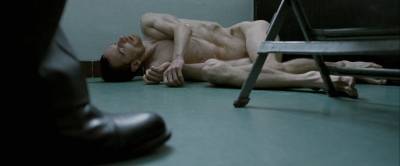
[click on the thumbnail to enlarge]
- Michael Fassbender Interview (14 min.; SD): Hunger's star delves into how he brought his own interpretation of Bobby Sands to life on film, attempting to recapture the spirit of a man he came to know through Sands' family, friends, and the writings he left behind. Not unexpectedly, much of this conversation swirls around Fassbender's startling weight loss to portray the starved Sands in his dying days as well as the extensive preparation that went into shaping a 22 minute conversation captured largely in a single take. Finally, Fassebender touches on his experiences working alongside a director making his first conventional narrative as well as the critical response to a film he doesn't see as being particularly political.
- The Making of Hunger (13 min.; SD): The disc's making-of featurette is well-crafted, although much of this territory has already been tread in the pair of interviews before it, such as Fassbender's disinterest in merely mimicking Bobby Sands and the filming of a single conversation that spans more than twenty minutes in length. Among the other comments from the many participants featured here are the purity of Sands' decision to go on a hunger strike, exploring the violence and graphic imagery of the film, the lengths taken to ensure that its characters aren't thinly-sketched heroes or villains, and the infectious passion McQueen inspired on the set. "The Making of Hunger" manages to address quite a bit in its lean runtime, and its only fault is that so much of this has already been addressed elsewhere on the disc.
- "The Provos' Last Card?" (45 min.; SD):
Produced shortly after the death of Bobby Sands and while a number of his fellow prisoners continued their hunger strikes, this 1981 British news program explores the past, present, and likely future for the Provisional Irish Republican Army. It helps put the events of the film in a greater context for those who may not be familiar, and some of the imagery seen in Hunger is featured here as well, including a janitor in a haz-mat suit spraywashing a cell caked with human excrement and the sweater and khaki "uniform" snidely offered to the prisoners. We learn quite a bit about the recruiting practices and hierarchy of the IRA, a group better organized and far more selective than the public had been led to believe. The casualties of the conflict are also explored at length. This sort of historical background complements the film marvelously and is well worth taking the time to watch.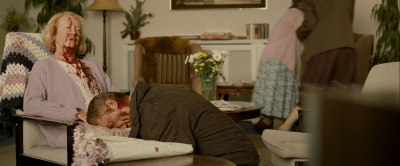
[click on the thumbnail to enlarge]
- Trailer (2 min.; HD): The last of Hunger's extras is its theatrical trailer.
The extras on this Blu-ray disc are encoded in high definition, but all except the trailer and the interview with Steve McQueen have been upconverted from lower resolution sources. Hunger also comes packaged with a booklet featuring an essay by film critic Chris Darke.
The Final Word
The ferocity of Hunger's performances fused with Steve McQueen's unflinching direction and the film's unsettling imagery make for a devastatingly powerful experience. This is an artfully crafted and uncompromising story of self-sacrifice, equal parts beautiful, brutal, and philosophical. Emotionally ravaging though Hunger may be -- perhaps too draining for most to be willing to endure it a second time -- this is an extraordinary work of art that demands to be seen. Hunger's presentation on Blu-ray is nearly as exceptional as the film itself, boasting a spectacular high definition presentation and an equally effective master-quality soundtrack. The selection of extras may appear to be lean at first glance but accomplish more in an hour and a half than most Blu-ray discs can in twice that time. Highly Recommended.
|
| Popular Reviews |
| Sponsored Links |
|
|
| Sponsored Links |
|
|
| Release List | Reviews | Shop | Newsletter | Forum | DVD Giveaways | Blu-Ray | Advertise |
|
Copyright 2024 DVDTalk.com All Rights Reserved. Legal Info, Privacy Policy, Terms of Use,
Manage Preferences,
Your Privacy Choices | |||||||









